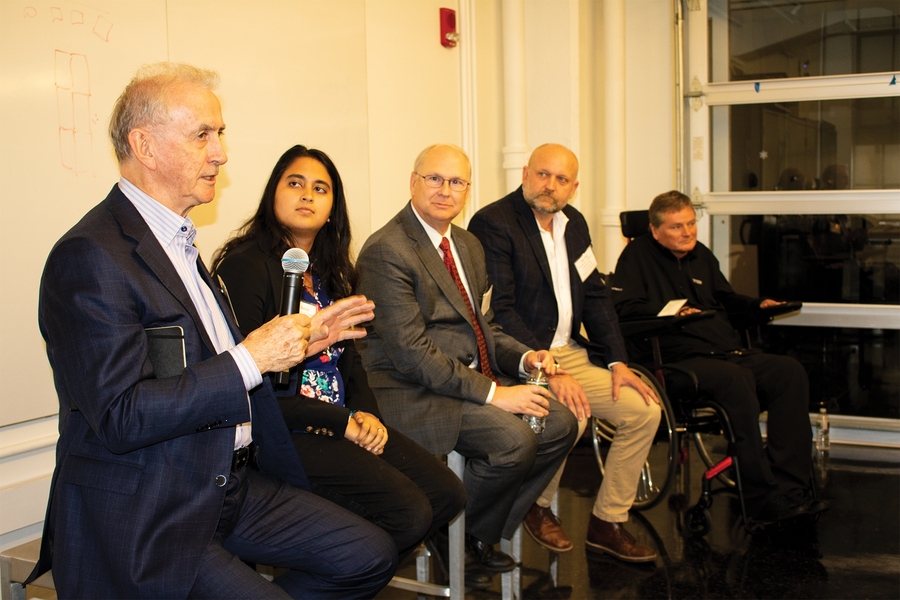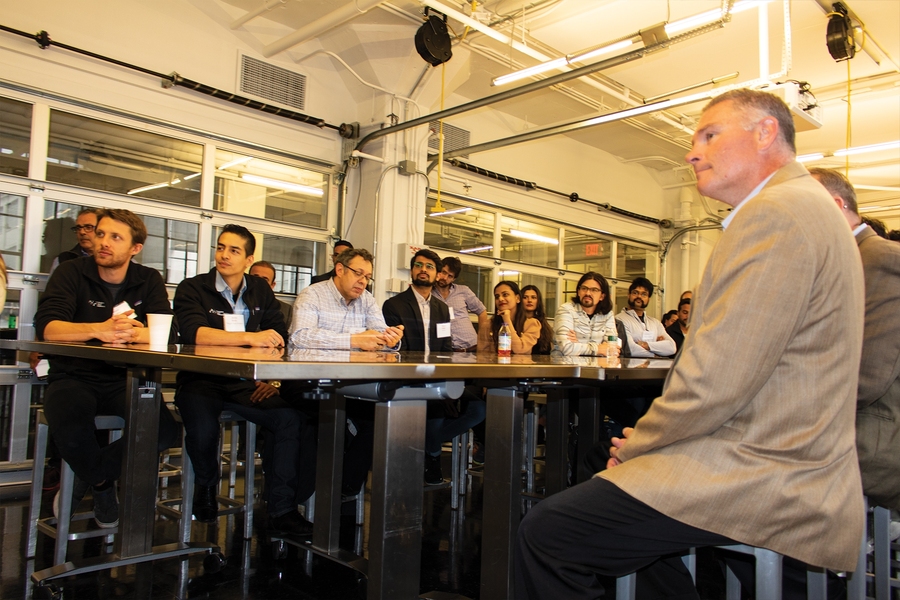In early October, the MIT International Design Center and the MIT Edgerton Center hosted a panel discussion on “Envisioning the Future of Technology-Enabled Mobility.”
Moderated by Edgerton Center Director and Professor of Ocean and Mechanical Engineering J. Kim Vandiver, panelists included Robert Bond, chief technology officer of MIT Lincoln Laboratory; Dan Frey, professor of mechanical engineering and MIT D-Lab faculty research director; Neville Hogan, the Sun Jae Professor of Mechanical Engineering; and Jaya Narain, PhD candidate in mechanical engineering at the Fluid Interfaces Group in the MIT Media Lab.
Also on the panel was Sam Schmidt, a professional IndyCar driver paralyzed from the shoulders down after a racing crash. He thought he’d never drive again. But he did.
Schmidt attained a top speed of 192 mph on a jet runway driving a modified Chevrolet Corvette, the SAM car (Semi-Autonomous Motorcar), developed by Arrow Electronics. Wearing a headset connected to infrared cameras that detected his head rotation, Schmidt steered. He used a sip-and-puff device to accelerate and brake.
Harmonizing human and robotic movement
According to Bond, one of the exoskeleton technology breakthroughs may soon be the integration of machine learning and microelectronics. “But it's also going to require a new actuator and new sensing technologies so that we can use machine learning to anticipate motion of the human, and then have the exoskeleton move in harmony with the human,” Bond said.
“Earlier skeletal types of technologies were very awkward for people to use. And they almost worked against the human as they were trying to use it,” Bond added.
One of the challenges “in developing these technologies — for example, with exoskeletal devices — they have to respect what the human does, the natural cadences of human movement,” said Hogan. Exoskeletal devices, for instance, need to get the right mix of technology and human movement. To demonstrate, Hogan asked the audience to move their arm from point A to point B in exactly 60 seconds, essentially “roboticizing” their arm movement. It was impossible.
Meaningful connections
Narain, who as an undergraduate co-founded ATHack, a two-week annual hackathon focused on assistive technologies, noted that the movement toward “do-it-yourself” technologies has played a valuable role in creating solutions for very specific needs.
Simple projects — rearview cameras for electric wheelchairs, braking mechanisms for walkers — have been built in hackathons, but “with 3D printers and Arduinos and things like Google's core app for machine learning, brain-computer interfaces, I think it's going to become a lot more feasible for people to kind of start taking technology and developing it for themselves and people they know,” said Narain.
What Narain finds inspiring is when students build relationships with the assistive-technology user. Students meet co-designers who propose a project. Students visit them at home, at work, where they're going to use the technology. “Maybe it's a basketball court. Maybe it's work. And when they have that rapport and that emotional connection, we found that those are the students who tend to stay in the space and continue with the project and other similar projects,” Narain said.
Frey confirmed the sentiment. “If you present problems to students that are technologically challenging and socially relevant, the rest takes care of itself,” he said.
“Basically, you have to beat them off with sticks if there's social relevance there … there's no problem attracting students,” said Hogan.
Extreme affordability
Schmidt notes that “maybe only 10 percent or 15 percent of the population of people with disabilities can afford a $60,000 [semi-autonomous] minivan … There's a lot of people not getting out of their houses because of the limitations.”
Vandiver, who had visited Jaipur Foot in India, a maker of prostheses with a reported 1.78 million beneficiaries, asked, “How do we see that people who live on the extreme affordability side of the world benefit from some of the things that we're thinking about here?”
Frey pointed out “that a huge proportion of this planet cannot pay a lot for the technologies. And the vast majority of all commercial engineering is focused on relatively few people.”
One of the Lincoln Laboratory projects was challenging people to build prosthetics using 3D printers, “feet and hands and things of that sort. And what they kind of stumbled onto was, for young children who are growing up that need a limb, basically, they're growing and growing and growing. And they can't afford to continually replace that limb. But if you can codify a scalable and quickly manufacturable [one] with a 3D-printed prosthetic, they can just go print a new one a month later that fits them again,” said Bond.
“It's not the best. It doesn't perform as well as the really high-tech ones,” Bond added. “But you get to refit it every month if you need to. So we should be thinking about how these new manufacturing technologies can just help us in doing things that might seem rather simple, but I think could have huge impact.”
Toward the future
Frey suggested using a related technology with a large market, such as cellphones, as the core of assistive technology. “As in, find something that already has a big market and kind of piggyback onto it,” he said.
The event gave everyone an opportunity to network and consider ways to collaborate further; many numbers were exchanged. And, at the end, everyone had the chance to look under the hood of semi-autonomous technology in action — the SAM car parked in the Edgerton Center’s Area 51 garage.











